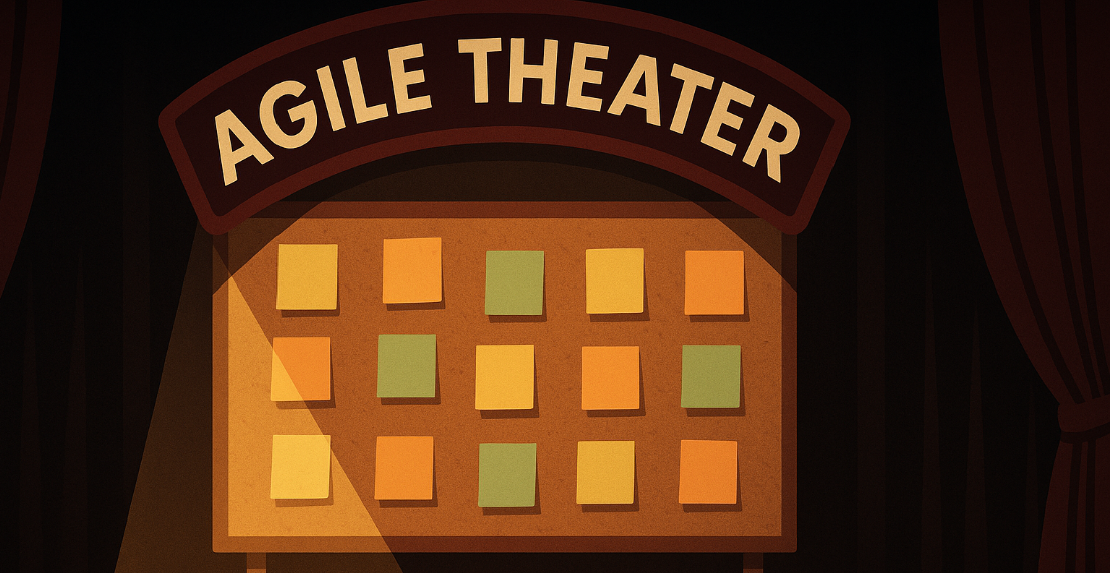SAFe gives leaders a comforting sense of order: roles, layers, roadmaps, and predictable increments. But too often, that
“safety” hides something familiar – Waterfall dressed up with agile terminology.
On paper, SAFe promises agility at scale. In practice, it often turns into months-long planning cycles, extra layers of
governance, and top-down control with new names. The labels change – “epics” instead of projects, “program
increments”
instead of deadlines – but the behaviors stay the same.
Which brings us to the real question: Is SAFe actually helping companies become agile, or is it just Waterfall in
disguise?
The Challenge with SAFe Itself
SAFe wasn’t designed as a trick. It’s a genuine attempt to solve the problem of scaling Agile in large, complex
enterprises. And at first glance, it offers structure, alignment, and predictability.
But those same qualities are also where it stumbles:
- Over-engineered layers
Portfolio, Large Solution, Program, Essential – each comes with its own roles and acronyms. Soon your org chart
looks like a giant process poster, and nobody’s sure who actually makes the decisions.
- Big-batch planning baked in
Program Increment (PI) planning is pitched as collaborative alignment, but in practice it functions like a
months-long commitment session.
- Governance over people
Agile started as a rebellion against heavyweight process. With SAFe, ceremonies and governance often take center
stage, leaving the people doing the work in the background.
At its best, SAFe creates clarity. At its worst, it rebuilds the rigidity Agile was meant to dismantle.
How Companies Misuse SAFe
The framework is heavy on its own, but the way companies use it is often worse. Too many organizations adopt SAFe as a
way to rebrand old behaviors instead of changing them.
Patterns show up quickly:
- Top-down rollouts
Leadership declares “We’re going SAFe,” and teams are pushed through training they never asked for.
- Deadlines in disguise
PIs turn into fixed commitments. Scope creep becomes PI creep.
- Project thinking with new labels
“Epics” or “initiatives” replace “projects,” but funding and governance stay exactly the same.
- Agility theater
Leaders show off a big SAFe diagram, but delivery practices on the ground don’t change.
The result? More process, not less. Teams carry the weight while executives get dashboards and optics.
Why This Happens
It’s not hard to see why SAFe is appealing in the boardroom.
Executives crave control and predictability. Quarterly PI planning feels reassuring; it provides roadmaps,
milestones, and a sense of certainty. For leaders raised on Gantt charts and status reports, SAFe speaks their native
language.
It also provides familiarity. Unlike lightweight approaches such as LeSS or Nexus, SAFe doesn’t ask leaders to give
up much power. It wraps Agile practices in layers of structure that feel comfortable to those used to hierarchical
management.
And let’s be blunt: SAFe enables optics without discomfort. Leaders can say, “We’ve gone Agile” without changing how
they actually lead. The culture – empowerment, trust, experimentation – stays the same. The framework
becomes a costume, not a catalyst.
That’s why SAFe spreads so easily. It lets organizations rebrand themselves without doing the hard, uncomfortable work
of cultural transformation.
The Consequences
This illusion of agility comes with a price.
Teams quickly realize that despite the new titles, they don’t actually have more empowerment. Decisions are still
centralized. Priorities are still handed down. Their autonomy is mostly rhetorical.
The additional layers and ceremonies mean that delivery slows down instead of speeding up. By the time a feature
makes it through the governance maze, the market has often moved on.
And perhaps most damaging, the core values of Agile get buried. Customer collaboration, rapid feedback, small
experiments – they get replaced by process compliance and meeting cadence. The energy that was supposed to go into
learning and adapting ends up going into producing artifacts and aligning with roadmaps.
In short: SAFe risks giving organizations the worst of both worlds – the rigidity of Waterfall combined with
the
overhead of scaled Agile.
What to Do Instead
Scaling Agile doesn’t have to mean adopting the heaviest framework in the catalog. The goal isn’t to scale
bureaucracy, it’s to scale principles: autonomy, collaboration, and a relentless focus on delivering value.
Below are some approaches that tend to work better in practice.
Keep It Small
Big transformations often fail because they start big. Instead of designing a full-blown operating model up front, begin
with the lightest structure you can get away with.
Add layers of coordination only when the pain of not having them becomes impossible to ignore. This way, your scaling
approach grows out of real needs rather than wishful planning.
Empower Teams
Agility at scale lives and dies with team autonomy. If your “Release Train Engineer” functions like a renamed project
manager, you’re just recreating old command-and-control dynamics.
Push decision-making closer to the people doing the work. Give teams ownership not just of delivery but of direction:
what gets built, how it’s built, and how it’s validated with users.
Focus on Outcomes
Too many organizations still measure success by whether features ship “on time.” But a feature that arrives on schedule
and fails to move the needle for customers is just waste delivered efficiently.
Shift your metrics to outcomes: churn reduced, adoption increased, satisfaction improved. When teams are measured by
impact rather than activity, agility starts to mean something tangible.
Experiment with Lighter Scaling
Before reaching for SAFe, try lighter approaches. Frameworks like LeSS or Nexus emphasize simplicity and transparency
over ceremony. I’ve seen 100-person orgs align with nothing more than Scrum of Scrums plus a quarterly strategy
workshop.
These models won’t impress with giant posters, but they’ll often deliver faster learning and less overhead.
Culture Before Framework
No framework will succeed if leadership clings to control. Culture change has to come first. That means training leaders
to embrace empowerment, trust, and experimentation, even when it feels uncomfortable.
Frameworks can be helpful scaffolding, but without a cultural shift, they quickly turn into theater – process for
the sake of optics rather than progress.
Conclusion: No, but…
Is SAFe just Waterfall wearing a hoodie? Not entirely. On its own, SAFe isn’t pure Waterfall – it contains
practices that can help align large organizations. In the right hands, with the right culture, it can work.
But here’s the catch: In most companies, SAFe doesn’t make agility easier. It makes it harder. Its layers and
ceremonies provide cover for leaders who want the optics of “agile” while keeping their old command-and-control
mindsets. For them, SAFe becomes the perfect disguise: Waterfall in fancy new wording.
If you suspect your SAFe rollout looks more like an excuse than a transformation, don’t double down. Strip back the
layers. Focus less on the framework and more on the principles: Empowered teams, fast feedback, and delivering
outcomes
that matter.



